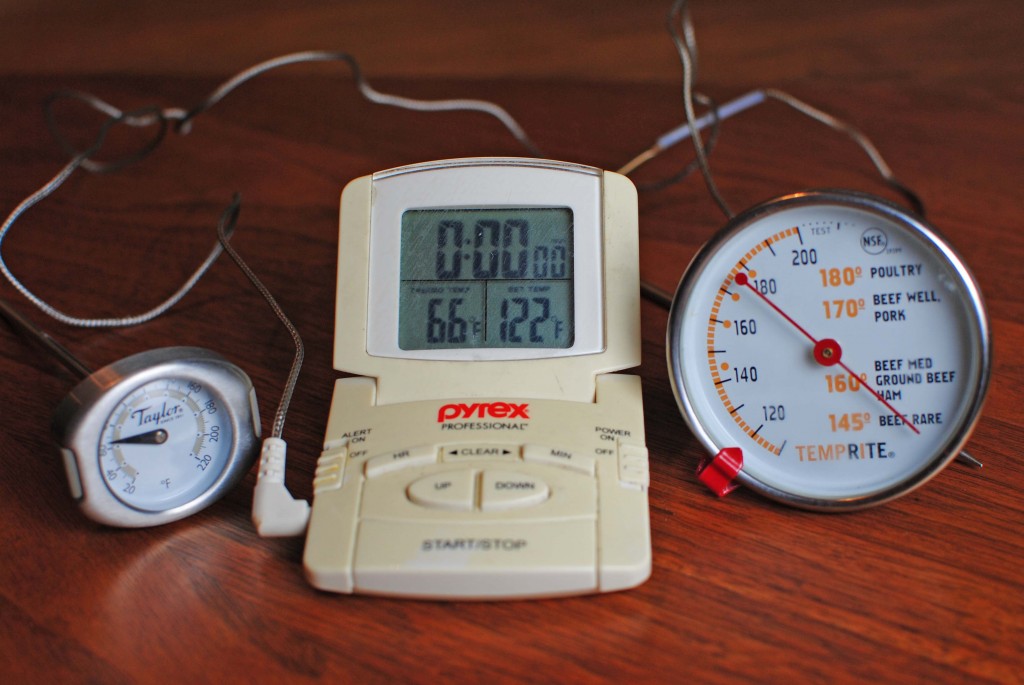
Each year my mother asks for my Christmas list. No, I’m not eight. I’m more than two decades older than that. Yet she still asks. And I still send one. (I also cc Santa just to be on the safe side.)
This year, I’m inclined to ask for a kitchen thermometer. It’s not that I don’t have a thermometer. I do. In fact, I have three of them — two dial thermometers and a digital thermometer with a removable probe on a cable (pictured above). But I don’t trust them. One was too cheap (“You get what you pay for,” says the voice in my head). One got wet (and now may or may not be accurate). And the other rapidly flashes between Celsius and Fahrenheit. I’m pretty sure it’s not supposed to do that. And none of them agree. What I’m after is the Cadillac of thermometers: ThermoWorks New Splash-Proof Super-Fast Thermapen. The drawback is the shock-inducing cost. Are you sitting down? The Thermapen is $96. Most other kitchen thermometers are in the $15-$20 range.
So that got me wondering what could possibly make this thermometer so special? Well, I did some research and came up with an answer — sort of.
There are a lot of different ways to measure the temperature. Let’s start with a simple one. Remember good old bulb thermometers? These contain a liquid such as mercury, which is trapped inside a glass tube with a bulb at the bottom. As the temperature rises, the liquid mercury in the bulb expands and travels up the tube. Simple!
Dial thermometers (like the Taylor and Temprite pictured above) rely on two different kinds of metal — for example, copper and iron — that are bonded together to form a strip. These two metals expand at different rates. So if the temperature rises or drops, the strip deforms. In a dial thermometer, this strip is wound into a coil that is attached to the needle. Changes in temperature cause the coil to wind tighter or loosen, moving the needle to the correct temperature.
Probe thermometers, like the Pyrex pictured above, are electric. They have a sensor called a thermistor, which is made from a semiconductor. Semiconductors don’t conduct electricity at low temperatures. As they warm, however, they become increasingly conductive. These thermometers tell temperature by measuring how easily an electric current passes through the semiconductor.
The Thermapen is an electric thermometer too, but instead of a thermistor, it has a thermocouple. To understand what that is, you first need to understand the Seebeck effect. Imagine stirring a pot of boiling soup with a metal spoon. At first, the handle will be cool. But eventually the heat will travel up the spoon and burn your hand. That’s because electrons are carrying heat from the hot end to the cool one. But it’s not just the temperature that’s changing. The electric charge is changing too. Electrons rushing into the cool end of the spoon create a voltage. That’s the Seebeck effect.
A thermocouple is constructed of two wires made from different metals. These are joined at a single point. As that point gets hot, electrons flow up the wires carrying heat and electrons. To get an accurate temperature, the thermocouple thermometer measures the voltage between the disconnected ends of the wire.
So the big advantage of the Thermapen is that you get a thermocouple. Worth it? Supposedly thermocouple thermometers provide highly accurate measurements. And Thermapens certainly are fast. See a comparison chart here. So . . . maybe. Let’s see if Santa can swing it.
**
I have no conflicts of interest to disclose (that is, ThermoWorks didn’t pay me to write this. Nor did they send me a free Thermapen, unfortunately).
I have one confession: I know nothing of physics/engineering. So I might have gotten this wrong (especially the part about the Seebeck effect). If I did, please correct me. The post is largely based on information I found in howeverythingworks.org (not that I blame them for any mistakes). See Section 6.6 on Thermometers and Thermostats. Here’s another fun link: Cooking For Engineers.
Image credit: Cassandra Willyard
I bought my mom a Thermapen for Christmas a few years ago. She loves it!